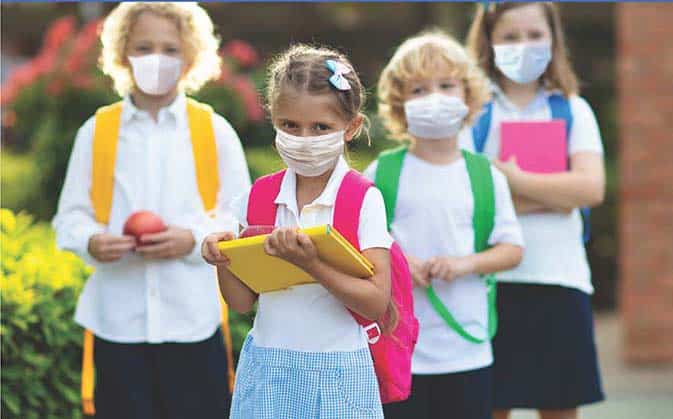
I Screen, You Screen, We All Screen for…Data?
January 28, 2020
Communication: Better Leadership
June 3, 2020by RABBI DR. DAVID FOX
Ba’boker tomar mi yiten erev (Devarim 28:67)
A challenge of these last months has been adaptation – limited access to other persons, quarantine, economic realities, discontinuation of synagogue and community life and perhaps most troubling, diminished access to school and to Torah education. From resilient professionals and educators, a host of innovations have been provided, as well as perhaps an overuse of virtual media, and these have helped somewhat in trying to lessen the sense of isolation from others, trying to create some facsimile of schooling.
This interval has been a challenge for teachers and for students, as well as parents, because telephone and computer screens are imperfect solutions. Audio presentations for visual learners, image presentations for tactile learners, very young children attempting to follow a phone lesson, limited student monitoring and accountability, and a restless student body beset by space limitations, siblings competing for phone access and for privacy, inundation with multiple virtual opportunities for both appropriate and distracting viewing, against the backdrop of knowledge that people are getting sick and some are dying – all of these novel realities have made this interval an unprecedented experience for child and adult alike.
We are now, in many communities, about to face another vicissitude, the return to school and to conditional re-socialization. This will present new challenges of adaptation. This article takes a psychological view of those challenges, both proactively and also retrospectively, given the enduring impact on our students and on ourselves of some 3 months of living with this health crisis and its effects.
Lingering Nature of Trauma
If a crisis is defined as an overwhelming event, a trauma is defined as a crisis unlike anything which one has ever experienced, which one has no referent for in their own personal life history. A trauma is a form of crisis with enduring effects on self and on actual brain functioning. When a trauma involves illness and death and is ongoing with no known remedy or solution, it is a catastrophic trauma. COVID-19 is a catastrophic trauma for those very reasons.
Children will be returning to school. Some have faced familial loss, or serious illness. Some know of others who have experienced loss. Some will meet up with classmates who may be orphaned or may have endured serious health crisis in the home. There may be classmates who are now gone. There may be faculty who are reeling with their own ordeals of trauma, and there may be teachers or staff who are now gone. When there is unprocessed, unaddressed trauma, there will be a strong emotional block to anyone rapidly acclimating to being back at school. This will require the focused concern of the school in being able to prep both child and adult for what will feel like a different school than was part of pre-COVID life.
Waking Up – Physiology
The brain can be malleable and can respond to conditioning. Sleep patterns, eating patterns, exercise and other factors are mediated, essentially, by the brain and with time and circumstance, the brain will adjust its rhythms to the needs and the demands of each person. Student’s brains have already been conditioned to their current schedules. The return to a school schedule will impact those rhythms. Getting up for school, the car pool or commute, staying awake during class, focus, concentration, attention and motivation will lag until the brain is again reconditioned, which can take weeks and at times months. This will take its toll on classroom atmosphere and on teacher frustration.
Waking Up – Psychology
After many weeks of quarantine and its demands, despite the resistance many of us had to accepting that “new abnormal”, many children enjoyed the relative freedom from schedules, from bedtimes and waking times, from having to get dressed in school clothing, and the rather relaxed routine. This will not be easily relinquished despite the lure of seeing friends and classmates again. Moreover, the relative dearth of mental stimulation which has been part of staying home with less structure, as well as the diminished productive cerebral stimulation which is a consequence of excessive digital media exposure, will find teachers struggling to marshal student motivation and interest in arousing rusty minds. The brain requires time to regain its prior focus. The unexercised brain, like the languished body in which it is housed, may fatigue quickly after prolonged inactivity, and may have initial trouble reactivating its dormant, stored information. This will demand patience on the part of teachers, as students gradually wrestle to activate and to catch up. We will have to anticipate regression from, and loss of, prior attainment levels.
Growing Accustomed to Our Pace
Psychological science has long identified the “approach-avoidance” conflict, wherein the closer one gets to an anticipated goal, the slower one seems to move ahead. Although many have complained about wanting this to be over so that they can return to their former life routines, a certain complacency develops as we accustom ourselves to what has become familiar. For young persons who do not worry about having to get back to a job so as to earn a living, the lack of routine and the virtual freedom from demands may have become familiar and even comfortable. We have to anticipate a reluctance to get back in the saddle among our students, and even among some faculty.
Spare Time
Children find ways to occupy themselves, with or without the guidance of parents. Internet access can expose a child to unexplored frontiers and beyond. The effect on thinking, fantasy and even emotional energy and brain regulation can indispose the most conscientious child from relating to the standards and goals of Jewish education. Even families who have no internet access or who monitor their child’s viewing still must contend with the child’s excessive idle time and the new reality that the street, rather
than the home, the school, and the synagogue, may have become the primary influences on a child’s social awareness and psychological preoccupations. Premature exposure to more sophisticated concepts and images is also traumatic for the developing mind. Students may return to class, but may continue to seem distracted, furtive, disinterested and moody.
Existing Stresses
Quarantine means incubation. Families who focused on warmth, on wholesome relationships, supportive parenting and increased family cohesiveness may have equipped their children with fairly optimal values and healthy experiences during this interval. However, where there was family strife, or grieving, or pre-existing conflict and turmoil, the quarantine interval may have generated increased unhappiness in children. The relative absence of social or extra-familial outlets may well have insulated and preserved conflicts and tensions which a student will bring back to school. Teachers need to anticipate that whether or not a student is happy to be back at school, a student nonetheless may be unhappy because of their previous and existing home ordeal.
RULES OF RETURN
Mental Hygiene: Best Practices and Strategies
In preparing teachers for the return to school, it is very important to provide all faculty with a processing experience. Every person has suffered during this interval. It is normal to have reactions, and it is not normal to have no reactions. Whether one has faced loss and grief, or illness and debilitation, or loss of income, loss of professional role and identity, or has grown unaccustomed to maintaining a classroom structure and planning a curriculum, these weeks of trauma have to have taken a toll.
Common reactions include physical malaise, listlessness, fatigue, loss of energy, or restlessness, hyper-activation and other physiological fluctuations. An adult may experience distressed thoughts, pessimistic ideas, cynicism, flashbacks, and changes in memory, concentration and attention span. Other reactions can include moodiness, fear, anxiety, dysregulated emotions, frustration and irritability. One may have developed behavioral patterns and diversions – including healthy pastimes – which now must be relinquished or deprioritized. Some have become more insular and even spiritually so, and some may have experienced a drain of spiritual energy and interest.
Coming back to school with any difficult psychological experience or change needs to be processed. Firstly, if a teacher returns to school with pressing concerns or even with a story which they long to share, this can compromise their objectivity in being there for their students. Students are not equipped to hear and to attend to a distressed teacher, so the teacher must be prompted to first address their issues with peers, with mentors, with supervisors, so as not to contaminate the classroom, where students may be having their own struggles and have their own stories to vent. Secondly, when adults have an opportunity to share their experiences with colleagues [with the facilitated oversight of a school counselor or a consulting mental health professional at the school, before the semester begins], the feeling that others identify with and can validate one’s own distress can help each one better frame their subjective dynamics so as to shield students from these matters. In the event that a teacher is actually impaired, the appropriate step would be to recommend personal counseling and guidance to that adult. Acute or post-traumatic stress, or unfinished grief, are quite possible given the realities which all have faced. A teacher who is too distraught to be an educational role model will require professional support and guidance. A third benefit of providing processing for the teachers is to sensitize them to the fact that students too may be returning to school with their own traumatic aftermath. This will aid the faculty in being perceptive of and supportive to those students who are scarred and need to work through it.
If mental health refers to the level of pathology or disturbance in an individual, mental hygiene is the “handwashing” and disinfecting to keep one’s self and others safe from the development of distress.
Student Mental Hygiene
This was not a vacation. Students will not be returning to school enthused with great stories to tell. This was a rough time, at many levels. Students are going to have reactions, are already having some reactions in the midst of the COVID crisis. Young people too react in their bodies, in their minds, in their emotions, in their behavior, and yes, in their orientation to religious practices and spiritual yearnings. Acute distress as well as post-traumatic distress are very likely to surface among some students, for all of these reasons outlined earlier in this article. Many of the students in distress have not had access to mental health intervention or treatment. Some may need that still. Anxiety and depression do linger.
What all students can respond to is the opportunity to process at school with the guidance counselor [if he or she is suitably trained for this] or with an outside consulting mental health professional. Each student at an age appropriate level will need time to reacclimate and to discuss what they have been doing, how they are now doing and what they are bringing back to the classroom within themselves. Those who have experienced loss or health related trauma will require support and understanding. Those who are not quite ready to shoulder the burden of hard school work will need patience and coaxing, and time. It is not reasonable to expect an idling engine to reach full speed instantaneously and the mental motor too needs time and practice before regaining momentum. The faculty should develop awareness of what each student has been dealing with, and accommodations, and it is possible that professional referrals will need consideration. Liaison with parents will also be part of the proactive preparation, to better understand each student’s circumstances, and to partner with parents in supporting the school’s renewed efforts to reconstruct its educational plans.
Detoxing the Distracted Brain
Only time and monitoring will inform us as to the long-term effects of students being out of school, with diminished learning, and with all of the deprivation from what we regard as the ideal conditions for successful Jewish education. We do need to assume that the reliance on digital technology has influenced the brain in cerebral, emotional and functional domains. We also know that this was for many communities a “hora’as shah” and was far from ideal at any level. And we know too that a child’s brain is affected by over-exposure to such technology, even for periods of more than half an hour. It is hard for a teacher in a conventional classroom to compete with the verve and the entertainment of the internet. It is hard to create a classroom atmosphere which now may feel underwhelming and unstimulating. Imagine if keyboards were unavailable and we had no choice but to revert to handwriting. That would require hand movements and speed decreases which would cause both muscle strain and lower productivity. We would not be interested in writing. Going back to lecture and classroom work may not grab the attention and interest of our students, who have been getting by “virtually”, and virtually without us.
The role and the task of educator as mechanech will become part of the new image. “Back to basics” and modeling for students the necessity, the benefits and hopefully the joy of learning how to work and to think with less dependence on technology will become part of the educator’s lesson plan. But to be sure, the brain will need reconditioning, and for many students, detoxification as well. The latter is a great challenge, because the educator is competing with a set of brain chemistry changes which are thirsty for stimulation. The educator is also going to compete with images and shortcuts which are far more exciting than many a lecture.
Paradise, Loss, and Lost
Although I touched on the mental states of both teachers and students, we cannot understate the impact of having faced death and loss. This has been particularly critical because in most situations, whereas there was grief, there were few mourning practices to structure that grief. Without formal shiva, nichum, kaddish and even levaya, the emotional repercussions of loss will still be felt among both adults and students. Classmates will require sensitivity building, about knowing what to say and how to approach a bereft friend. Teachers will need to consider possible modifications of parts of their own lesson plans when topics of death and dying, or of tragedy and of loss, invariably surface. As much as students may have longed to return to some semblance of normal school life, there will be changes, and losses. Students have missed out on courses, on social events, on academic milestones, on graduations and bar and bas mitzvos, and may not have entered a Jewish institution for months. Rather than feeling like a homecoming, “paradise regained”, the school atmosphere and all that it once provided and the allure which it may have once offered, may have been lost forever.
Adults can try to reframe this for young people, can try packaging the realities in a positive manner, or proposing “virtual graduations” and “drive-by bar mitzvos” but for some children, they would rather have their hurt validated then whisked away by the wishful thinking of a well meaning adult.
Residuals
Earlier, in discussing catastrophic trauma, I touched on how this current health crisis involves many unknowns as to its course and as to our own future. It may be a long while before science is given the Divine insight to discover a remedy for our world. Returning to school with the same fears, with the same precautions of hand sanitizers, masks, gloves and other measures will remain part of “v’inshmartem me’od” practices. This means that each day, each student and every teacher will have visible and tangible reminders which reinforce and concretize their anxieties, and which can trigger their residual sadness.
When Dovid HaMelech wrote about the eventual return from exile (Tehillim 126), he foresaw how we would be like dreamers, ha’yinu k’cholmim. According to ibn Ezra, this means that the relief of returning to a normal existence will be so immense that we will no longer take life for granted. It will all seem like a wonderful dream. According to the Meiri, this means that when we can begin to look back at all that we endured and suffered through, it will seem like a bad dream.
This has been a nightmare. It is my hope and intention that this article and its concepts will help us envision and implement a dream which is realistic while hopeful as well.
Rabbi Dr. Dovid Fox is the Director of Crisis Intervention, Trauma, and Bereavement services for Chai Lifeline. [email protected]

